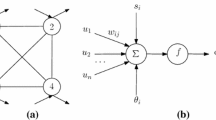Abstract
Multistability in perceptual tasks has suggested that the mechanisms underlying our percepts might be modeled as nonlinear, deterministic systems that exhibit chaotic behavior. We present evidence supporting this view, obtaining an estimate of 3.5 for the dimensionality of such a system. A surprising result is that this estimate applies for a rather diverse range of perceptual tasks.
Similar content being viewed by others
References
Altman EJ (1991) Dynamical systems approach to low-level integration of motion and binocular stereopsis. SPIE Proceedings: Curves and surfaces in computer vision and graphics II (November). Boston, Mass
Ben-Mizrachi A, Procaccia I, Grassberger P (1984) Characterization of experimental (noisy) strange attractors. Phys Rev A 29:975–977
Bergé P, Pomeau Y, Videl C (1984) Order within chaos. Wiley, New York
Essex C, Lookman T, Nerenberg MAH (1987) The climate attractor over short time scales. Nature 326:64–66
Fahle M, Palm G (1990) A model for rivalry between cognitive contours. MIT AI Lab Memo 1240 (Also Biol Cybern)
Grassberger P, Procaccia I (1983) Characterization of strange attractors. Phys Rev Lett 50:346–349
Jepson A, Richards W (1993) What is a percept? University of Toronto, Department of Computer Science Technical Report RBCV-TR-93-43. Also MIT Cognitive Science Memo 43, Center for Cognitive Science, MIT E10-120, Cambridge, Mass (1991)
Julesz B (1971) Foundations of cyclopean perception. University of Chicago Press, Chicago
Kadanov LP (1986) Chaos: a view of complexity in the physical sciences. In: Great ideas today, Encyclopedia Britannica, Chicago, pp 63–92
]Levelt WJM (1965) On binocular rivalry. Institute for Perception RVO-TNO, Soesterberg, The Netherlands
Malrasion B, Atteus P, Berge P, Dubois M (1983) Dimensions of strange attractors: an experimental determination for the chaotic regime of two convective systems. Phys Lett 44:897–902
May RM (1974) Biological populations with non-overlapping generations: stable points, stable cycles and chaos. Science 186:645–647
May RM (1976) Simple mathematical models with very complicated dynamics. Nature 261:459–467
Poston T, Stewart IN (1978) Non-linear modelling of multistable perception. Behav Sci 23:318–334
Priesol A, Borrett DS, Kwan H (1991) Dynamics of a chaotic neural net work in response to a sustained stimulus. Tech Report RBCV-TR-91-38, Dept. Computer Science, University of Toronto, October
Richards DE (1991) Modelling collective behavior with chaotic dynamics. Presentation at Annual Meeting of American Political Science Association, August, Washington, DC. See also: Behav Sci 35:219–232 (1990)
Richards W (1970) Oculomotor effects on binocular rivalry. Phychol Forsch 33:136–154
Skarda CA, Freeman WJ (1987) How brains make chaos in order to make sense of the world. Behav Brain Sci 10:161–195
Sommer MA (1993) Express saccades elicited during visual scan in the monkey. Vision Res (in press)
Ta'eed LK, Ta'eed O, Wright JE (1988) Determinants involved in the perception of the Necker Cube: an application of catastrophe theory. Behav Sci 33:97–115
Theiler J (1990) Estimating the fractal dimension of chaotic time series. MIT Lincoln Lab Jrl 3:63–86. (Also J Opt Soc Am A)
Van Buskirk R, Jeffries C (1985) Observation of chaotic dynamics of oupled non-linear oscillators. Phys Rev A 31:3332–3357
Xu J-H, Li W (1986) The dynamics of large-scale neuron-glia network and its relation to brain function. Commun Theor Phys (Beijing) 5:339–346
Yarbus AL (1967) Eye movements and vision. Plenum, New York
Author information
Authors and Affiliations
Rights and permissions
About this article
Cite this article
Richards, W., Wilson, H.R. & Sommer, M.A. Chaos in percepts?. Biol. Cybern. 70, 345–349 (1994). https://doi.org/10.1007/BF00200331
Received:
Accepted:
Issue Date:
DOI: https://doi.org/10.1007/BF00200331




